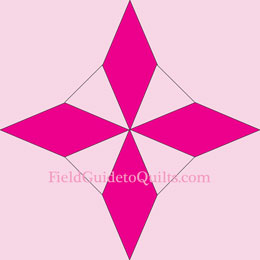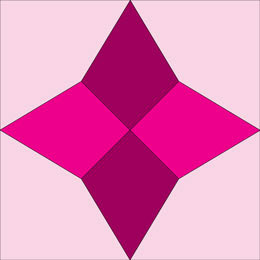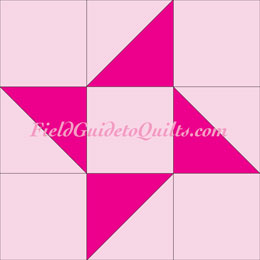| FieldGuidetoQuilts.org | |
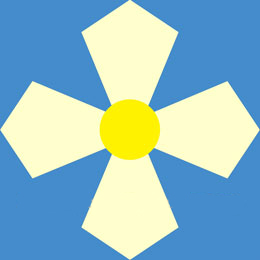 |
Plus stars |
Here are our four-point stars that are oriented like a plus sign. Click on a small icon to go directly to that block.
|
See also: |
Swords & Plowshares                Swords and Plowshares  The pair of small circles in each quarter of Swords and Plowshares is what looks like a plow. The pair of small circles in each quarter of Swords and Plowshares is what looks like a plow. Those circles represent bolt holes where the parts of a plow connected. The holes weren't always in the same place, and there weren't always just two, but there's no mistaking that the quarter-block piece represents a plowshare and furrow plates. The plowshare is the leading edge that cuts through the roots and soil. That part's sharp, so making one from a sword makes more sense than you might think. The plowshare attaches to two metal plates shaped to make the dirt curl outward to form a furrow. Then there's a long pole going forward that hooks to the trailing end of the horse's harness, and another pair of poles going backward to be handles for the farmer. Blacksmith John Deere's big insight, in 1837, was how to shape the furrow plates just right for making gummy Illinois soil curve into a furrow without sticking to the plow. We can't even remember if we drew up this graphic on a 70x70-square grid, as Jinny Beyer did for Quilter's Album of Patchwork Patterns (2009). We have, however, made it as close to the original Kansas City Star illustration as possible. Click on the "Make It!" icon for a diagram. |
Beautiful Star                         Beautiful Star in three colors                          Beautiful Star  Beautiful Star Beautiful StarLadies Art Co. #1 1897  Fancy Star Fancy StarThis block was #1 in the Ladies Art Company catalog of 1897. By then, the LAC had been publishing individual blocks for at least a decade. Writes researcher Connie Chunn, "a large majority of blocks were published in the 1880s through the 1890s." Click here to see Chunn's site: Since to our knowledge no block was ever re-numbered, we think Beautiful Star could literally have been the first block published by Henry and Emma Brockstedt, who formed the company in 1889. The original was in two colors. The name Fancy Star came along in 1931 in a pamphlet called Grandmother's Patchwork Quilt Designs. Beyer 297-1; Havig 90; Khin 217 |
Arkansas Snow Flake
|
Pontiac Star         ... as we think it was supposed to look 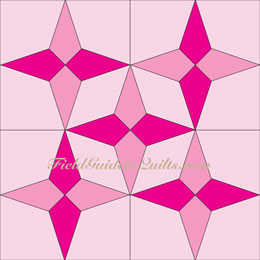 Pontiac Star Stone 1906          Pontiac Star as published and ... First published in 1906 in Clara Stone's Practical Needlework, Pontiac Star could date back to the 18th century. Chief Pontiac was an Ottawa who led Pontiac's Rebellion against the British in 1763-1766. Later settlers thought well enough of him to name their new town Pontiac in 1820. Whether the block is named for the chief or for the town we don't know, but it is not named after Pontiac automobiles, which first appeared in 1926. There's still another possibility: Once there were reports of diamonds found on Michigan's northern peninsula, where Pontiac stands. With poetic license, "stars" can stand in for "diamonds." For that matter, Lone Star quilts are made of diamond shapes ... but we digress. |
Michigan's Pontiac Star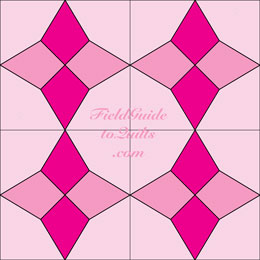 Michigan's Pontiac Star Workbasket 1915  Quilt historian Barbara Brackman cites Workbasket 1915 for this block, showing scraps for the horizontal points and a solid for the vertical points. Hers is the earliest cite we've seen. The block differs from Pontiac Stars in the placement of dark and light fabrics. In the Michigan block, all the stars are shown with light colors on the horizontal and dark colors on the vertical. Evelyn Foland of the The Kansas City Star wrote that "The pattern gives a pretty broken stripe the length of the bed and is very effective." The effect is especially pronounced in high-contrast colors. She called it The Kite Quilt. The Star's template was for a 10-inch block. KCS; Beyer 160-4; Brackman #3870, p. 472-3 |
Four Points         Four Points 
Four Points Ladies Art Co. #306 1897  Humming Bird/The Kite Quilt/The Kite/Star Kites/Snowball Humming Bird/The Kite Quilt/The Kite/Star Kites/SnowballThe Ladies Art Company's 1897 catalog included this block as #306. The name Humming Bird comes from Prairie Farmer (1928). Nancy Cabot called it The Kite and Star Kites (1933, 1937), while Snowball is from a 1954 Aunt Martha booklet. We thank Jinny Beyer and her Quilter's Album of Patchwork Patterns for the alternate names. We've reversed the LAC's dark and light colors to show the seam lines. Beyer 160-4 |
Danish Stars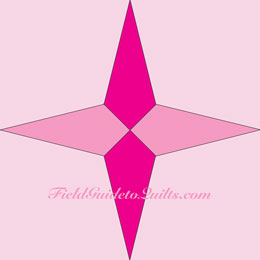                         Danish Stars Danish Stars  Danish Stars Kansas City Star, 1942 Those were "the scissors with which she had cut the pattern for this block," the Star noted. Such nostalgia tied quilting to the past even when it was crazily popular as a pastime, and helped make quilting itself an antique before its time. The block grid is 10x10. *The newspaper used the word "Stars" but illustrated a single block.KCS 1942 ; Beyer 193-3 |
Job's Troubles Job's Troubles Job's Troubles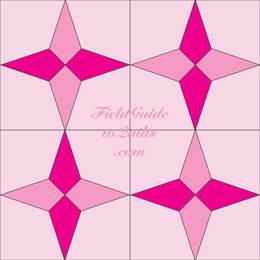 Job's Troubles Hall 1935          Job's Troubles Carrie Hall & Rose Kretsinger included Job's Troubles in The Romance of the Patchwork Quilt in America (1935). The alternate names are theirs. Every other star in a Job's Trouble's quilt is turned 90 degrees to break up the vertical stripe effect that the Star's Evelyn Foland praised in The Kite Quilt (Michigan's Pontiac Star). On the web, Job's Troubles is the name used for a split-point X star. Click here to see it: |
The New Four Pointer The New Four Pointer The New Four Pointer
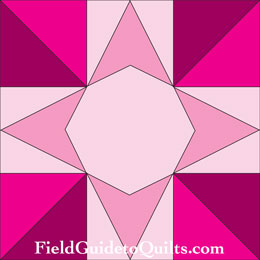 The New Four Pointer Kansas City Star, 1944  The New Four Pointer We've followed the Kansas City Star's choice of color intensities in our illustration at left, but if you want to emphasize the star points, you can swap out a corner color for the points. We've included an example. The New Four Pointer We've followed the Kansas City Star's choice of color intensities in our illustration at left, but if you want to emphasize the star points, you can swap out a corner color for the points. We've included an example.The block is from 1944, designed by a 7th grader named Betty Jean Perryman in Boone County, Missouri — so the newspaper tells us. It's drawn on a 12x12 grid, according to Jinny Beyer. KCS 1944; Beyer 159-12 |
Night and Day                         Night and Day 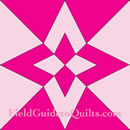 Night and Day Detroit Free Press 1937 |
The Southside Star Quilt The Southside The Southside Star Quilt Kansas City Star, 1940                          Southside StarIn 1940, The Kansas City Star credited this block to a girl named Ona Lee Jones of Damascus, AR, who named it after her school. Southside StarIn 1940, The Kansas City Star credited this block to a girl named Ona Lee Jones of Damascus, AR, who named it after her school. What happened to this precocious schoolgirl? In honor of our own Great-Aunt Ora, we tried to track it down. The U.S. Census tells us that in 1940, Onia (yes, Onia) Jones of Damascus was 56 and married. An Ona Lee Jones, age four, lived about 80 miles south in 1930, part of an African-American family of nine children, but in 1940 she's not listed there. Cheerful thinking leads us to hope that she was alive and welll, perhaps moving to Damascus to stay with a relative when the census taker missed her. If so, further cheerful thinking suggests that she went to the South Side High School that has existed since 1929 in Bee Branch, a six-minute drive from Damascus. However, not even cheerful thinking can make us believe that a backwoods Arkansas high school was integrated in the 1930s. That didn't happen till 1957 in Little Rock, and it was kind of a big deal. So: Was Ona Lee Jones a fiction made up by a Southside girl? Or did the Star invent her? Either way, why "Ona Lee?" Our mysterious Miss Jones's block was supposedly done in Southside school colors, which are blue and white, but who are we to get picky when the Star said they were blue and yellow? |
Stepping Stones                Stepping Stones Stepping Stones
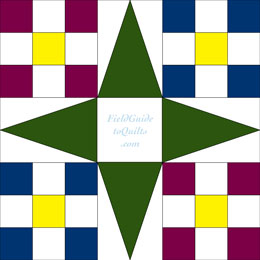 Stepping Stones Stepping StonesVirginia Snow Studios 1932  The earliest version of this design was in a Grandma Dexter booklet from Virginia Snow Studios, published about 1932. The earliest version of this design was in a Grandma Dexter booklet from Virginia Snow Studios, published about 1932. The Virginia Snow arrangement of five colors is reproduced at left. We think it's hideous, but it works surprisingly well as a whole quilt. The blue "Make It!" icon links to block instructions in Marcia Hohn's QuiltersCache.com, which makes a 16-inch block. |
Nose Gay                         Nose Gay Nose Gay
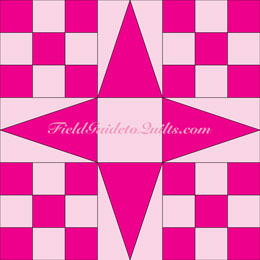 Nose Gay Nose GayChicago Tribune 1933  Since old blocks were almost always printed in black and white, we assume that this one was in two colors when the Chicago Tribune published it in 1933 as Nose Gay. A year later, designer Alice Beyer published it in the book Quilting as Nosegay. Since old blocks were almost always printed in black and white, we assume that this one was in two colors when the Chicago Tribune published it in 1933 as Nose Gay. A year later, designer Alice Beyer published it in the book Quilting as Nosegay. Most quilters weren't born yesterday, but for those who were, a nosegay is a small bouquet. (It makes your nose happy.) |
The Jewel Quilt The Jewel Quilt The Jewel Quilt
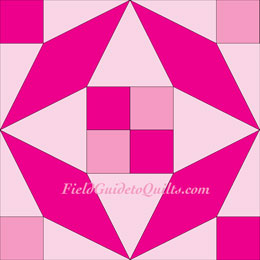 The Jewel Quilt The Jewel QuiltKansas City Star 1954                 The Jewel Quilt in colors the Star suggestedThe Jewel Quilt is unusual in having four large diamonds that do not meet in the center. Those diamonds are the most striking shape in a whole quilt of this design. In the block, however, they create an X-shaped star. The Jewel Quilt in colors the Star suggestedThe Jewel Quilt is unusual in having four large diamonds that do not meet in the center. Those diamonds are the most striking shape in a whole quilt of this design. In the block, however, they create an X-shaped star. We've included a second mockup in the colors recommended by the Star: red, blue, and green. It doubtless looks better in fabric than it does in our mockup. The block is laid out on a 6x6 grid. |
 |
|
